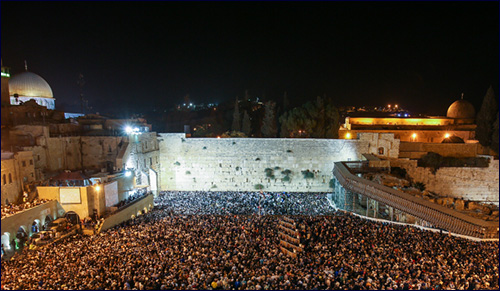 Iran’s Attack on Israel
Iran’s Attack on Israel


5 min read
What draws tens of thousands of Jews, night after night, to the midnight Selichot service?
Tens of thousands of Jews from all over Israel, most of them not religious, come to the Old City of Jerusalem, night after night at this time of year. What draws them? Not a rock concert, nor a massive sale, nor a political demonstration. They come to participate in “Selichot,” penitential prayers appealing for God’s forgiveness.
These prayers are recited every night at midnight, starting for Sephardic Jews at the beginning of the Hebrew month of Elul, for Ashkenazi Jews on the Saturday night before Rosh Hashanah. Young and middle-aged, groups organized by places of employment as well as families and couples, they head first to the Old City’s Jewish Quarter, and then on the Kotel (Western Wall) for Selichot. What years ago was a placid stream has become in the last few years a virtual tsunami of Jewish souls. By the night before Yom Kippur, a hundred thousand people will crowd into the Kotel Plaza to chant the traditional pleas for Divine forgiveness.
A resident of the Jewish Quarter, I was on my way home one Thursday night. The narrow, cobble-stoned lanes of the Jewish Quarter make it hard to pass people, so as I squeezed by one couple, I greeted them with a “Shalom.” They looked to be in their forties, she with shoulder-length brown hair, he wearing a black tee-shirt. The man asked if this was the way to the Kotel. It wasn’t, but I offered to show them the way and struck up a conversation in Hebrew.
They were from Natanya, a 90-minute drive from Jerusalem. They said they had come for Selichot. “But it’s only 8:30,” I told them. “Selichot don’t start until midnight.”
The man shrugged. “It’s okay, we have time. We’ll hang around.”
“We took a hotel room in Jerusalem for tonight,” the woman explained. “We have all the time we need.” She hesitated, then added plaintively, “But tell me, what do you say in Selichot?”
I stopped short. These people had come all the way from Netanya and had spent money for a hotel room in order to go to Selichot at the Kotel, but they had no idea what to say. Clearly, it was their first time.
“The essence of Selichot,” I explained, “is the 13 Attributes of Divine Mercy. These were revealed by God to Moses after the sin of the golden calf.”
She was listening attentively, nodding her head, so I continued. “When the Jewish People recites these 13 Attributes, they draw down Divine mercy. That’s what God promised when He revealed them to Moses.”
“But what are the words?” she wanted to know.
So, standing there on Chabad Street above the 1400-year-old pillars of the Roman Cardo, I started teaching her the 13 Attributes of Mercy. “The first two are the Name of God, twice. The first time it refers to God before we sin, and the second time it refers to God after we sin, because God does not change no matter what we do.”
She was eager to hear more, so I continued, telling her each attribute with its commentary. She repeated each word, over and over, trying to memorize them so she’d know what to say at the Kotel. Her husband was leaning on the balustrade, gazing at the giant, lit-up dome that dominates the Jewish Quarter.
“That’s the Churva Synagogue,” I explained with the quiet awe that wells up in me every time I look at it. “It was destroyed by the Arabs twice, but four years ago, it was rebuilt, exactly as it was before 1948.”
“Does it have a minyan for Aravit [the evening prayer]?” he asked.
My surprise at his query, since he did not look religious, must have been evident on my face because he hurried to explain, “I want to say Kaddish.”
The evening prayer at the Churvah was already over, but I suggested that he could catch a minyan at the Kotel. His wife, however, wanted to know the rest of the 13 Attributes.
“Nosei avon, v’pasha, v’hataah, [forgiver of iniquity, willful sin and error],” I recited, and went on to explain the difference between the three kinds of sins and that God forgives them all. Rapt, the woman hung on every word.
“There’s one more,” I concluded. “The last one is Nakei (Who cleanses).”
“Nakei!?” she asked in utter amazement. She knew that nakei means “cleans,” as in cleaning a dirty floor, but apparently it had never occurred to her that it was possible to clean a sin-stained soul.
“Yes, Nakei.” I repeated. “If we do teshuvah (repentance), really do teshuvah, God cleans us.”
“Nakei?” she asked again in wonderment, her eyes as big as the giant dome.
“Yes!” and gesturing from my head toward my toes, I exclaimed, “White, completely white. As it says, ‘Even if your sins are red as scarlet, He will make them white as wool.’”
She stood there frozen in awe. She had never known that a soul soiled by teenage follies and adult downfalls could return to its pristine purity.
“That’s what teshuvah is,” I clarified. “It undoes the past. It’s a Divine gift. A miraculous Divine gift.”
Her husband was impatient to move on. She thanked me over and over again, as if I had given her a check for a million shekels. “Nakai,” she kept repeating as she scampered toward the Kotel, joining the masses of other Jews streaming there to be forgiven by God as Yom Kippur draws near.
Aish Israel attracts 1,000 Israelis every night during Selichot to their one-hour program of music, humor and Torah at the Aish World Center.
For an inside look, watch this video below from Israel's Channel 2 News.
